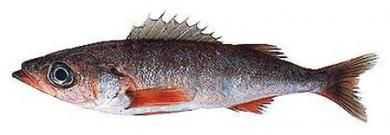Shortbelly Rockfish

Species Details
Sebastes Jordani
Sebastidae
Scorpaeniformes
Water Columns
1 - 1 lbs.
6" - 14"
Shortbelly Rockfish (Sebastes Jordani) Fish Description
Shortbelly Rockfish have a dark brown dorsal portion that slowly turns into light pink before it turns white at its underbelly. Its dorsal fin appears to be split into two sections. All in all, it has 13 dorsal spines but 13-16 dorsal rays. Its name comes from the placement of the vent. Unlike its other cousins (Sharpchin, Canary, and etc.), the Shortbelly Rockfish’s vent is midway between the pelvic fin and the anal fin. This makes it easier to identify it among the other Rockfishes.
Unlike other Rockfish, the Shortbelly Rockfish does not have those distinct black bars that its cousins have. Instead, it has a fading gradient that runs vertically. They also have big eyes that appear disproportionate to its body.
Diet and Size
Shortbelly Rockfish have a medium-sized terminal lip. This makes it easier for them to feed on zooplankton or krill. Normally, they feed at night along the water column where most of the zooplankton and krill can be found.
Among all the Rockfish, the Shortbelly Rockfish is one of the smaller species. The Shortbelly Rockfish is known to only reach 14 inches. Usually, it’s the females that reach 14 inches. Male Shortbelly Rockfishes can be quite small. Their weights usually range between 0.5 to 0.8 lbs.
Interesting Facts about the Shortbelly Rockfish
- Shortbelly Rockfishes have an average lifespan of 32 years.
- They’re usually the favorite prey of Salmon, Ling Cod, other Rockfishes, Fur Seals, and some random sea birds.
- Unlike other Rockfish, the Shortbelly Rockfish is quite narrow in terms of body structure.
- Because they’re so small, Shortbelly Rockfish are usually ignored in terms of commercial fishing.
- However, there have been studies that are investigating if Shortbelly Rockfish are good enough to be turned into pet food.
- Others began testing the feasibility of the Shortbelly Rockfish meat in becoming surimi. The ground fish-meat used in making Crabsticks.
- Shortbelly Rockfishes seem to prefer staying midwater, unlike its cousins.
Fishing: How to catch a Shortbelly Rockfish
As of now, there are not many resources on how to catch the Shortbelly Rockfish because of the lack of market. However, this doesn’t mean that there are some principles that can’t be applied. For example, Shortbelly Rockfish – as nocturnal feeders – are usually more active at night. The best time to find them is usually at night at the water columns where they might be looking for some krill and zooplankton to feed on.
For equipment, there’s no need to use heavy equipment. Unlike the other Rockfish that stay in the deeper parts, the Shortbelly Rockfish is usually swimming midwater. Like other rockfish, it may respond to certain lures made from certain materials such as bucktails. For the bait, best to find yourself some krill. Although zooplankton is also a good choice, you’ll have to use a white lure to attract them. Most zooplankton is white in color so having a white lure will fool the fish into thinking that your bait is zooplankton. For hook size, maybe a size 10 will do. Or even a 1/0 hook will do. Having a large hook might attract bigger Rockfish or bigger fish, turning your Shortbelly Rockfish into the bait instead.
Habitat and Distribution
Shortbelly Rockfishes often live as a school of fish. They usually stay by the water column or aggregate at the bottom of the water. They can live in a variety of habitats and are often moving around, not really having a specific choice of place. However, as juveniles, Shortbelly Rockfishes are pelagic which means they prefer the surface.
As they get older, however, Shortbelly Rockfishes are often on the move or swarming near a water column.





